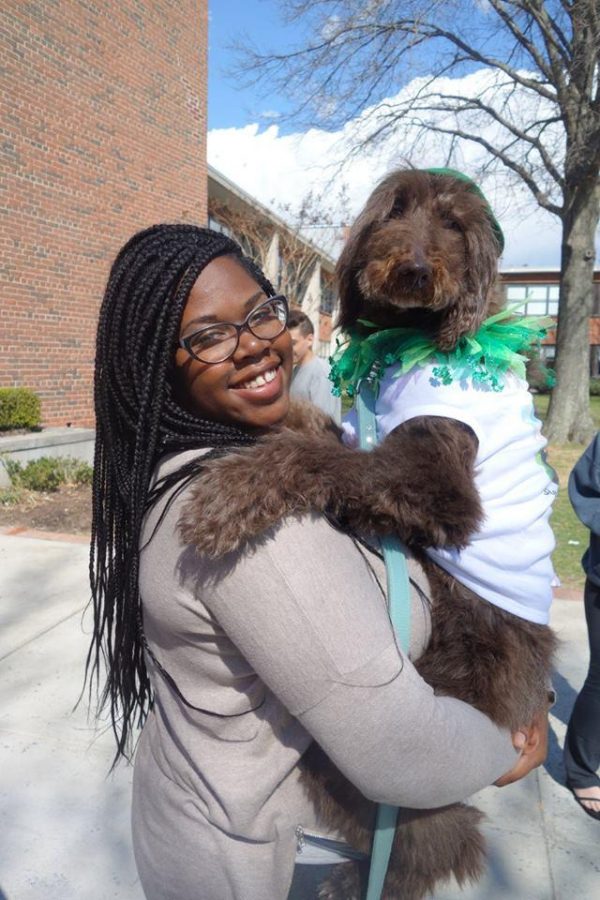Bet You Can’t Resist Petting Harris And Stella
Therapy Dogs Brighten Mercy College’s Day
Students crowded the Main Hall on St. Patrick’s Day to pet and hold the five therapy dogs lingering around outside.
Harris and Stella couldn’t wait either.
Though the animals looked like regular dogs dressed up in green outfits, they had much more significance. They were ready to be spoiled with affection, love, and excessive petting.
Harris and Stella were the students’ favorite for that exact reason.
Therapy animals are best known for bringing comfort, affection, and happiness to people in confined living situations, whether they are in a hospital for a short stay, or living in an assisted living home or cancer center.
They are crucial to stricken households because sadly, occasionally family and friends are too uncomfortable to visit their ill or elderly loved ones because of their condition. Connecting with an animal can bring a smile and warm memories to those who feel lonely or neglected.
Research has shown that contact with a therapy animal helps improve a patient’s physical, mental, emotional, and social state, which in turn helps them better engage and participate in the process of their treatment and recovery.
Harris, a 3-year-old 80-pound Australian labrador, was excitedly nuzzling his way into not just each student’s hands but also their hearts. With his young energy, he was the hardest to contain of all the dogs when his excitement arose.
His owner, Marissa Levy, named her Australian lab after her grandfather, whose middle name was Harris, because of his strong affection for dogs. After spending two years in training, Harris spends much of his time in hospitals, specifically interacting with Senior Citizens.
“He loves lying with older men and woman in their hospital beds. It’s like a tranquilizer. It’s calming and the patients love cuddling with him,” Levy says.
Harris’s friend, Stella, aka the princess, is also his sidekick.
Stella is a 5-year old poodle, who is not only the number one therapy dog in the country, but also has her own children’s book written after her called “Stella: The Dog With The Big Heart.” She is quite the crowd pleaser as she had an autograph signing and has her own Facebook fan page with 238, 070 followers.
Thanks to her personal doggy designer, she has a dress for every holiday and gets her fur straightened for special occasions, like her appearance on ABC and Good Morning America.
Her fame comes from her loving personality and her ability to work so well with children. Stella mainly works with cancer children and spends a lot of her time at the American Childhood Cancer Association in Kensington, Maryland. She has taken trips all over the country, specifically to Disney World, with the Make a Wish Foundation.
Her owner, Lisa, who is Marissa’s daughter, adopted Stella at four months old. Lisa lost her father, a dog, and her best friend all three months apart from one another and decided to get a new dog to lift up her spirits. After adopting Stella, she quickly realized how special she really was. People would always ask her if she considered making Stella a therapy or service dog, so Lisa looked into it.
Therapy dogs cannot begin their training until they are one years old, so once Stella was eligible, Lisa took her in to be evaluated. Ninety-nine percent of canines need to be trained in order to become therapy dogs, but Stella passed every part of her evaluation with flying colors, resulting in her being part of the 1 percent not to need training.
Therapy dogs training evaluations generally include handling disruptions such as seeing another dog in their proximity or clumsy children. These coached dogs will react to such disturbances just as anyone would, but the point of training is to quickly regain composure and should not cause the animal to panic.
Harris, one of the youngest dogs among the group, quickly became very excited once new therapy dogs arrived on campus, but his owner was easily able to have him regain composure.
“I just plant my legs firmly to the ground and tell him to calm down and he does. I trained him with food because what dog doesn’t like food? So, I reward him with food for listening to me,” Levy states as she hands him a treat.
Therapy animals come in all shapes and sizes, but the most important characteristic is not their breed, species, or appearance, but their personality, say experts. They are friendly, patient, gentle, and at ease with strangers while providing unconditional acceptance and smiles on the faces of children and adults.
The introduction of therapy dogs occurred in 1944 when Bill Wynne was serving with the 5th Air Force in New Guinea. A friend found a 4-pound Yorkshire Terrier in a foxhole, and Bill adopted the miniature dog and named her Smoky.
Smoky suffered all the anguishes and dangers of war. He flew with Bill through the Pacific and lived off his C-rations, which are individual pre-cooked meals in a bag. Even with Bill working 12-hour shifts, seven days a week, him and Smoky spent much of their down time enjoying each other’s company and learning tricks together.
One day, Bill became hospitalized with a jungle disease, and his Army buddies brought Smoky to see him. Smoky’s tricks he had learned brought great pleasure to the other patients, and the nurses let Smoky stay with Bill. Over time, Smoky accompanied incoming veterans.
After the war, Bill and Smoky continued their work, visiting hospitals throughout the 1940s and into the 1950s. Beyond their services to the military, Bill and Smoky became popular on TV, and their continued adventures eventually led them to Hollywood.
Just as Smokey demonstrated, a therapy animal must enjoy human contact and excessive petting as well as be comfortable staying in place, whether on a floor, chair, bed or lap.
Unlike service dogs, therapy dogs are not allowed to enter the workforce unless used as a source of comfort. They are not required to perform tricks, though knowing a few will most definitely bring pleasure to their audience. Harris’ trick of “giving paws,” which entailed him throwing his paws up in the air, was a sure crowd pleaser at Mercy College.
“This was not our first time attending Mercy College and hopefully it won’t be the last,” Lisa says with a smile on her face. “We enjoy bringing our dogs here to see the students, and I know for a fact that Harris and Stella enjoy it too.”

Laine Griffin is from the one and only Washington D.C. and is a journalism major at Mercy College. Her hobbies range from playing sports, bartending, spending...








